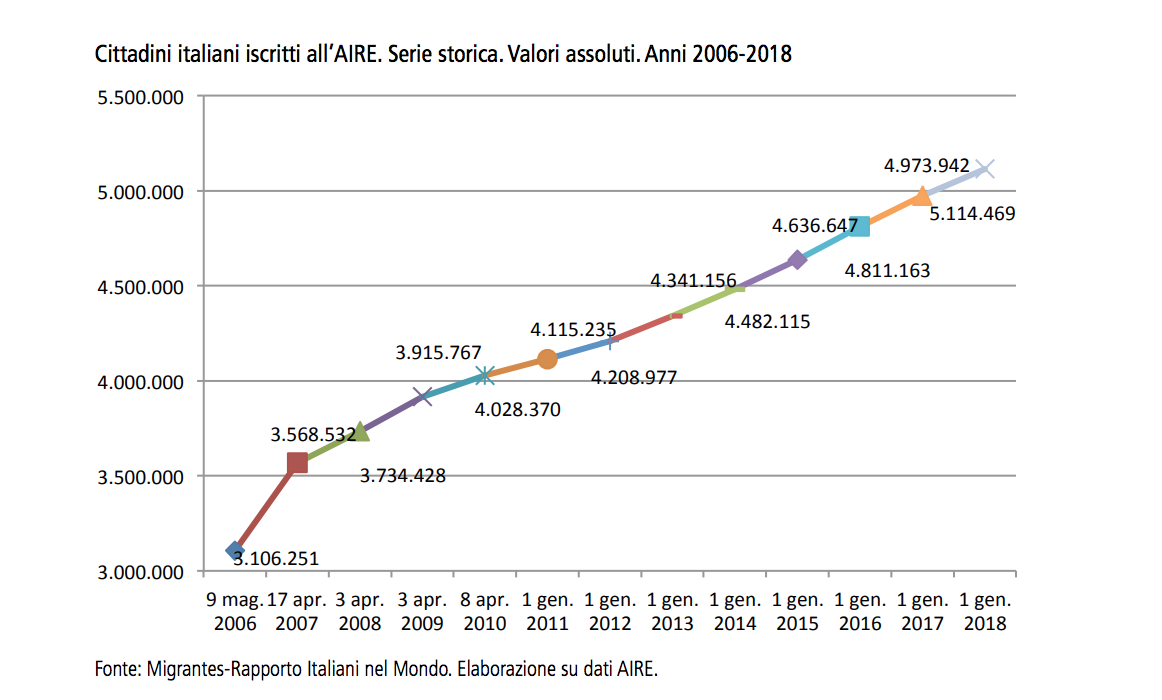A Deeper Look at Italian Emigration
As of January 1st, 2018, over 5.1 million Italians are registered in the official registry of Italians residing abroad, the AIRE (Anagrafe degli Italiani Residenti all’Estero.) That’s 8.5% of the country’s total population.
This is just one of the figures presented in the Migrantes Foundation’s Italians in the World Report, a document which compiles as much data as possible to analyze the state of Italian mobility in an attempt to go beyond simply remarking that Italy is experiencing a “brain drain.”
In order to do so, the report looks at how many people are leaving Italy and how those numbers evolve over time. Then, it goes on to examine both where they are going and which regions of Italy seem to be losing the most citizens. Finally, it considers various demographic factors to get a sense of who they are.
By bringing together all this information, we can gain a better, more precise understanding of why people are leaving and of how to appropriately address the issue.
How many Italians are leaving the country
Italian mobility increased by 2.7% between 2017 and 2018 and by 64.7% since 2006, raising the number of people listed in the AIRE from 3.1 million to 5.1 million. And these numbers continue to grow: from 2017 to 2018, the Italian community residing abroad increased by 2.7%.
Where they are moving to
Europe hosts the largest number of Italian residents: 54.1%, most of them (40.3%) within the European Union, while 40.3% live on the American continent, mostly in the South-Central region (32.4%)
During the last year, Germany was the favored destination, counting 20.007 residents and beating by far the UK (18.517) and France (12.870) which respectively are in 2nd and 3rd place.
Which parts of Italy they come from
49.5% of Italians residing abroad come from the South (1.659.421 from the mainland and 873.615 from the islands), while 34.9% are from the North (901.552 from the North-West and 881.940 from the North-East), and 15.6% from the Center, that’s 797.941 people.
However, the increase in mobility from 2017 to 1018 was generally stronger in the North, especially in Lombardy (with a variation of +23.591) and Veneto (+17.495).
And, in fact, in total, the main departure region is Lombardy (21.980), followed by Emilia-Romagna (12.912), Veneto (11.132), Sicily (10.649) and Puglia (8.816).
It’s important to consider though that bigger metropolitan areas such as Milan, Rome, Genoa, Turin, and Naples are amongst the main places from which Italians are departing because they are the most inhabited areas as well as those that host the most formative facilities such as schools, universities, academies, etc.
Who they are
In terms of demographics, it seems that slightly more men (51.9%) than women (48.1%) reside abroad. And 55.3% are single while 37% are married.
765 thousand are minors (15%) and 6.8% of them are under 10-year-old; 1 million 135 thousand are aged between 18 and 34 (22.2%); 1 million and 197 thousand between 35 and 49 (23.34%); 19.1% are between 50 and 64; and 20.3% are 65 or older.
This latest set of data is particularly interesting because, while Italians are well-aware of the phenomenon often referred to as “brain drain” - one often hears discussions, both on TV and in the streets, around the fact that many young people have to look beyond national borders to find employment, recognition or opportunity - it appears that this is only one aspect of a much more complex situation.
In fact, the data reveals that the issue is more complex than that. Though many young people are leaving, (some of them still go abroad driven by passion and dreams and in some cases manage to find success, while others just do so because they feel that there is no other alternative and end up taking jobs far below their qualifications in order to get by) they are not the only ones, in fact they are not even the majority.
That middle range of adults aged between 35 and 49 and even the ones between 50 and 64, which together make up a whopping 42,44% of those registered in the AIRE, mostly represent the people who have lost their jobs but are still far from retirement. They too are having a hard time finding employment in italy.
As for the older generations, though many people leave with the intention of coming back to the ‘belpaese’ for their retirement, there are also many people who actually decide to spend their retirement abroad, in places like Morocco, Thailand, Portugal, Spain, where the climate is pleasant and life more affordable.
Many Italians are aware that people are leaving and have a vague notion about it being related to the lack employment opportunities but they don’t go much beyond that. Though thinking about this issue may be a bit depressing or at least discouraging, it’s important to examine the phenomenon in detail, to truly understand it. First of all because it can help us understand our country better and where the core issues lie, and from there figure out how to address them.
Part of the solution lies in getting better, more unified and coherent statistics on how many Italians are leaving, who they are, where they are going, and why they are doing so. In fact, not everyone signs up to the AIRE, though the Ministry of Foreign Affairs is focused on ensuring that they do.
On a similar note, it’s also important to create unified networks of Italians abroad so that they can stay connected to each other, to their homeland, and in some cases even move back, this time with new insight and ideas that could benefit the entire country.








































i-Italy
Facebook
Google+
This work may not be reproduced, in whole or in part, without prior written permission.
Questo lavoro non può essere riprodotto, in tutto o in parte, senza permesso scritto.